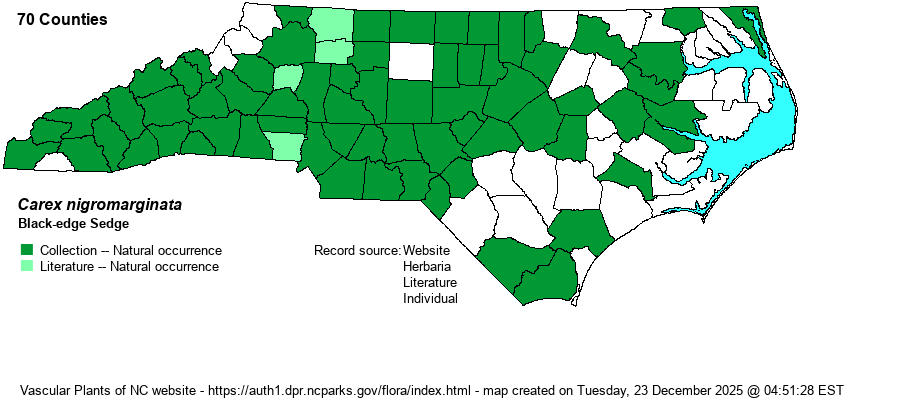| Author | Schweinitz | |
| Distribution | Most of the state, less often in the Coastal Plain. In 2022 Derick Poindexter annotated all specimens at NCU herbarium; these represent 42 counties in the state. Counties with specimens at SERNEC not represented at NCU are: Ashe, Brunswick, Caldwell, Caswell, Cherokee, Columbus, Halifax, Haywood, Henderson, Iredell, Jackson, Johnston, Jones, Lincoln, Macon, Madison, Pender, Polk, Scotland, Swain, Wilkes, and Yancey. These need to be double-checked for ID. Alternatively, new specimens should be collected in those counties, using the key in Weakley et al.
NJ to WI south to GA and TX. | |
| Abundance | Frequent over most of the state; uncommon in the Coastal Plain, and seemingly rare in the extreme eastern counties. The NCNHP's State Rank of S3? is woefully conservative; the website editors clearly rank this as an S5 species. | |
| Habitat | Dry to mesic hardwoods and pine-hardwood forests. Often on steep slopes and at crests of slopes where more light penetrates. Tolerates a wide variety of soil types and pH. |
| Phenology | Flowering and fruiting late March-May. | |
| Identification | This is a short Carex, appearing as a tuft of dark green leaves, which must be parted to see the flowering stems that are mostly just 3-7 inches tall (rarely more than 9 inches). Scales of perigynia are dark brown to purple brown, often lustrous. It differs from C. albicans by its dark perigynia (vs. pale greenish) and from C. floridana by possessing short rhizomes or none (vs. long). | |
| Taxonomic Comments | None, but see also C. floridana.
The genus Carex is the largest in North America, and among the largest in the world. In temperate and boreal regions, Carex is often the dominant or co-dominant ground layer in many habitats. Seeds (achenes) are valuable food for birds and small mammals, while foliage is used by birds and mammals to make nests and as food by mammals. Species of Carex often look vastly different from one another -- spikes erect vs. drooping, tiny inflorescence vs. whopping, culms leafy vs. naked, perigynia beaked vs. beakless, stems densely bunched vs. single, etc. The genus has been divided into many sections (or groups), based on shared characters; some taxonomists have suggested that these be different genera, but that proves unworkable (so far). All Carex share the feature of a perigynium (an outer covering) which completely surrounds the achene (seed). This covering may fit tightly or loosely (like a small bladder), depending on which group or species. Details of perigynia shape, ornamentation, presence and size of beak, number of striations (or veins) are all important ID features. In recent years Rob Naczi and colleagues have stressed the importance of arrangement of perigynia -- whether spiral (3+ ranks) or distichous (2-ranked) -- and have named a number of new species as well as split off some older synonyms. Therefore, RAB's (1968) key, excellent for its time, can only be used in a general way today. Members of some sections of Carex are difficult to key out (notably Ovales, Laxiflorae, Griseae); this is in part due to variation among individuals of a species, or failings of the key. FNA has drawings of most species and some species may be found in two or more places within a key, to acount for variability. New species to NC, and new to science(!), continue to be found in NC. | |
| Other Common Name(s) | None | |
| State Rank | S3? [S5] | |
| Global Rank | G5 | |
| State Status | | |
| US Status | | |
| USACE-agcp | FACU link |
| USACE-emp | UPL link |

